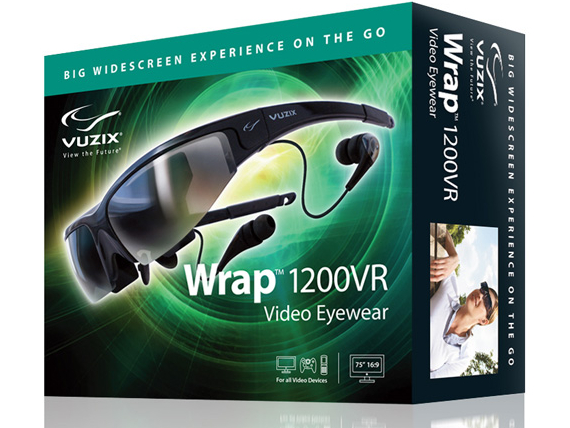Vuzix's 3D Headgear Creates Virtual 75-inch Display
This headset provides visuals equivalent to watching 3D content on a 75-inch display from 10 feet away.

Monday Vuzix launched its Wrap 1200VR, a 2D/3D headset that supposedly offers the equivalent to watching 3D content on a 75-inch display from 10 feet away. But unlike Sony's recently-announced HMZ headset, Vuzix's offering doesn't look like a visor ripped out of the X-Men comics, but rather a cool set of shades with built-in earphones... for the PC or console.
"The Wrap 1200VR allows our customers to step into another world, creating an immersive gaming or movie watching experience," said Paul Travers, CEO Vuzix Corporation. "With new tracking sensor technology and improved WVGA displays that support resolutions of up to 1280 x 720 (720p), the Wrap 1200VR provides the best consumer level VR solution available today."
According to Vuzix, the headset supports the latest side-by-side 3D video format and uses a new head-tracking technology called Wrap Tracker 6TC (with compass). This tech includes 9 sensors that work together to create a 3-degree of freedom solution with automatic drift compensation. The 1200VR is even supported by more than 100 titles for 3D video and/or head tracking including Call of Duty: Modern Warfare, Fallout 3, F.E.A.R and more.
"The Wrap 1200VR is the only consumer virtual reality system featuring individual focus for each eye and has optics that allow the user to position the displays to match the user’s IPD (Interpupillary Distance or eye separation)," the company said monday. "This enables optimum display positioning in front of each eye (much like binoculars) to ensure the best user viewing experience possible. Like other Wrap models, the 1200VR fits comfortably over most prescription eyeglasses."
Monday Vuzix said the 3D specs connect to virtually any graphics card installed a desktop or laptop computer sporting Windows 7, Vista and XP (32 and 64-bit versions) via VGA, DVI and USB 2.0 ports. Optional interfaces also enable the Wrap 1200VR to connect to component video devices like the Xbox 360 and PlayStation 3 consoles.
The Vuzix Wrap 1200VR is available now at www.vuzix.com for $599.99. The full list of specs can be seen here.
Sign up to get the BEST of Tom's Guide direct to your inbox.
Get instant access to breaking news, the hottest reviews, great deals and helpful tips.
Kevin started taking PCs apart in the 90s when Quake was on the way and his PC lacked the required components. Since then, he’s loved all things PC-related and cool gadgets ranging from the New Nintendo 3DS to Android tablets. He is currently a contributor at Digital Trends, writing about everything from computers to how-to content on Windows and Macs to reviews of the latest laptops from HP, Dell, Lenovo, and more.
-
back_by_demand OK, combine this with a Kinect sensor and an accellerometer and you have Virtual Reality gaming.Reply -
alchemy69 "support resolutions of up to 1280 x 720" is meaningless drivel. The screens are 852 x 480Reply -
thebigt42 faazrahxeI wonder if the resolution is 720p native or not.Reply
alchemy69"support resolutions of up to 1280 x 720" is meaningless drivel. The screens are 852 x 480
When they get true HD with HDMI connections and a price under $300 I might be in. If they don't make me sick or give me a migraine! -
thebigt42 What is this a sales pitch? Please give more accurate specs. Don't give me the manufactures lie of "support resolutions of up to 1280 x 720" when the true resolution of the screens per the manufactures link is "Twin high-resolution 852 x 480 LCD displays"Reply -
Spanky Deluxe Hmmmm.... let's see, $599 for this hunk of lo-res junk or $600 for Sony's 720p per eye HMZ-T1 VR headset.... let me think...Reply -
cats_Paw No reason to rush it, ill wait for something that is actually "worth" spending the money on.Reply -
masterbinky I fail to see why OLED can't be used, or used more effectively. They really fit the application perfectly, they are their light source (which is why most HMD (head mounted displays) are large and bulky) , OLEDs can easily have high density to make for a high resolution per eye, the major problem with OLEDS is manufacturing them in large panels WHICH AREN'T AN ISSUE for HMDS. In fact they can make the displays wrap the entire field of vision for the best 3d experience. For video games, this could revolutionize 3D. With two cameras one for each eye and some simple (eye tracking IS simple especially when you allow for a calibration) you could get feedback as to what the user was looking at and the distance the eye is trying to focus at to actively change the 3D rendering focal point to completely trick the eye removeing the aspect that strains people's eyes.Reply -
alidan masterbinkyI fail to see why OLED can't be used, or used more effectively. They really fit the application perfectly, they are their light source (which is why most HMD (head mounted displays) are large and bulky) , OLEDs can easily have high density to make for a high resolution per eye, the major problem with OLEDS is manufacturing them in large panels WHICH AREN'T AN ISSUE for HMDS. In fact they can make the displays wrap the entire field of vision for the best 3d experience. For video games, this could revolutionize 3D. With two cameras one for each eye and some simple (eye tracking IS simple especially when you allow for a calibration) you could get feedback as to what the user was looking at and the distance the eye is trying to focus at to actively change the 3D rendering focal point to completely trick the eye removing the aspect that strains people's eyes.Reply
before oleds were used in phones, they had the tech up to 1080p at 1.3 inch screens.
hell with oled glasses, i would be willing to dump my monitor for them. as i don't think i would need to ware my glasses with them.
its sad that no one will bring this tech out in a timely fashion.
